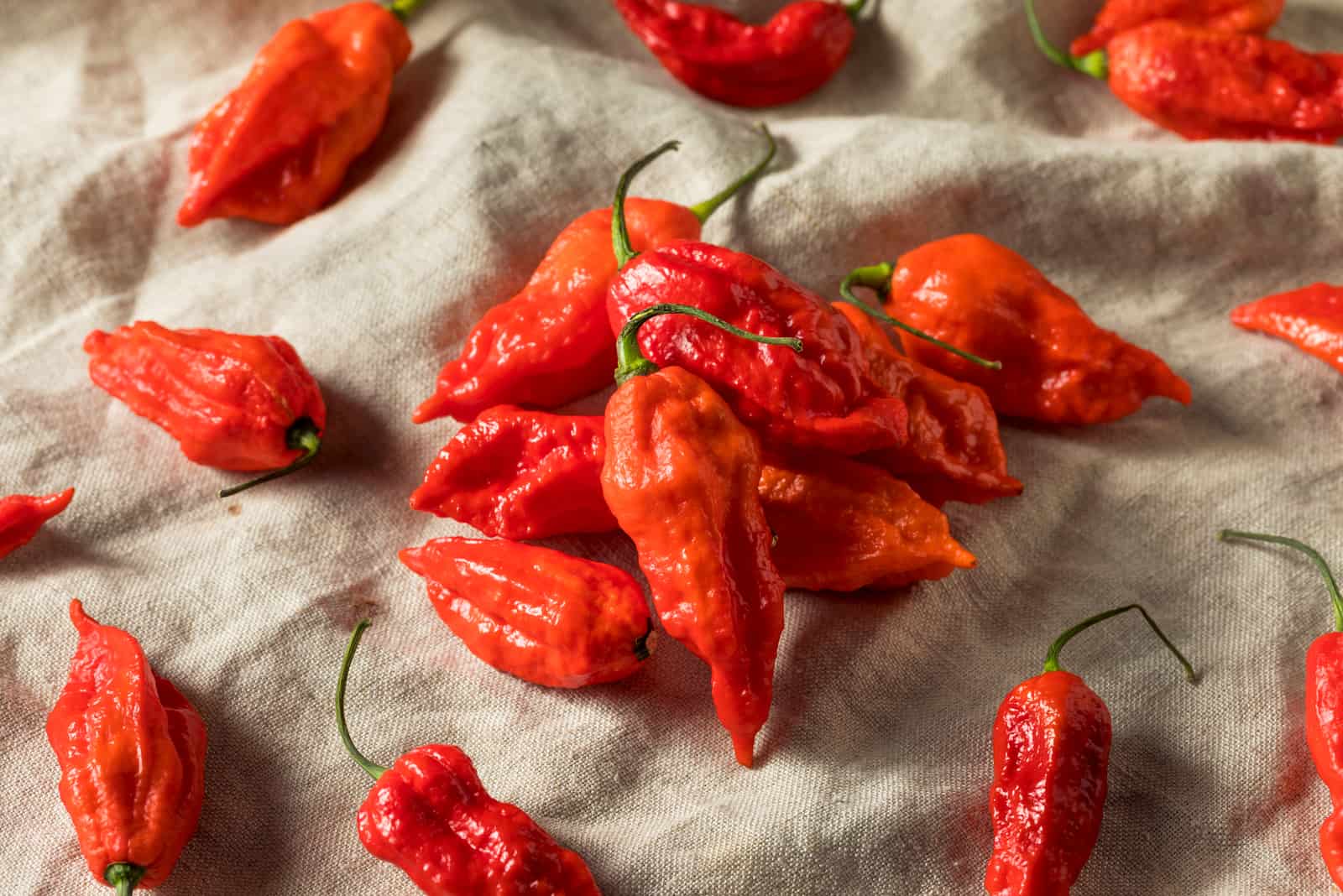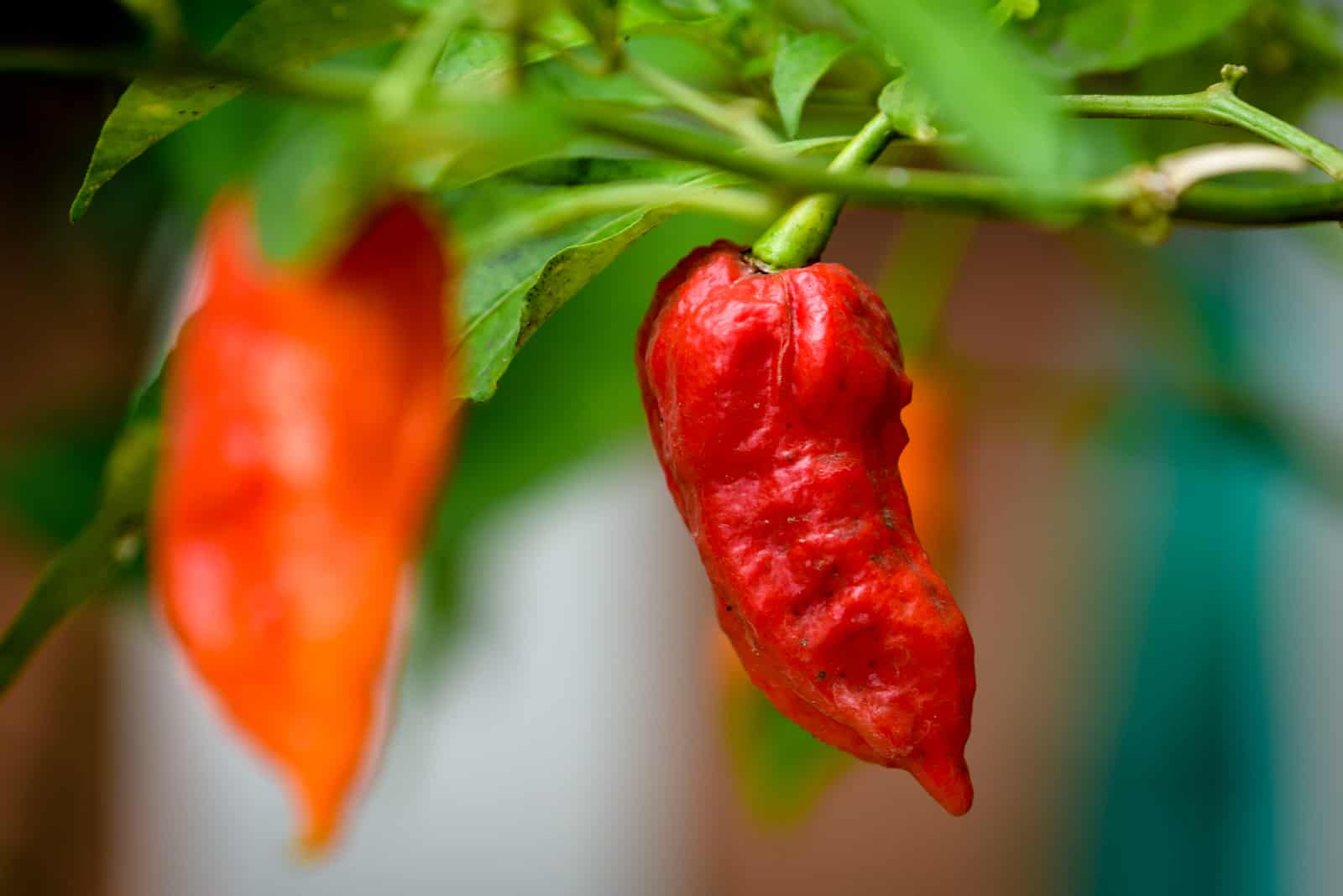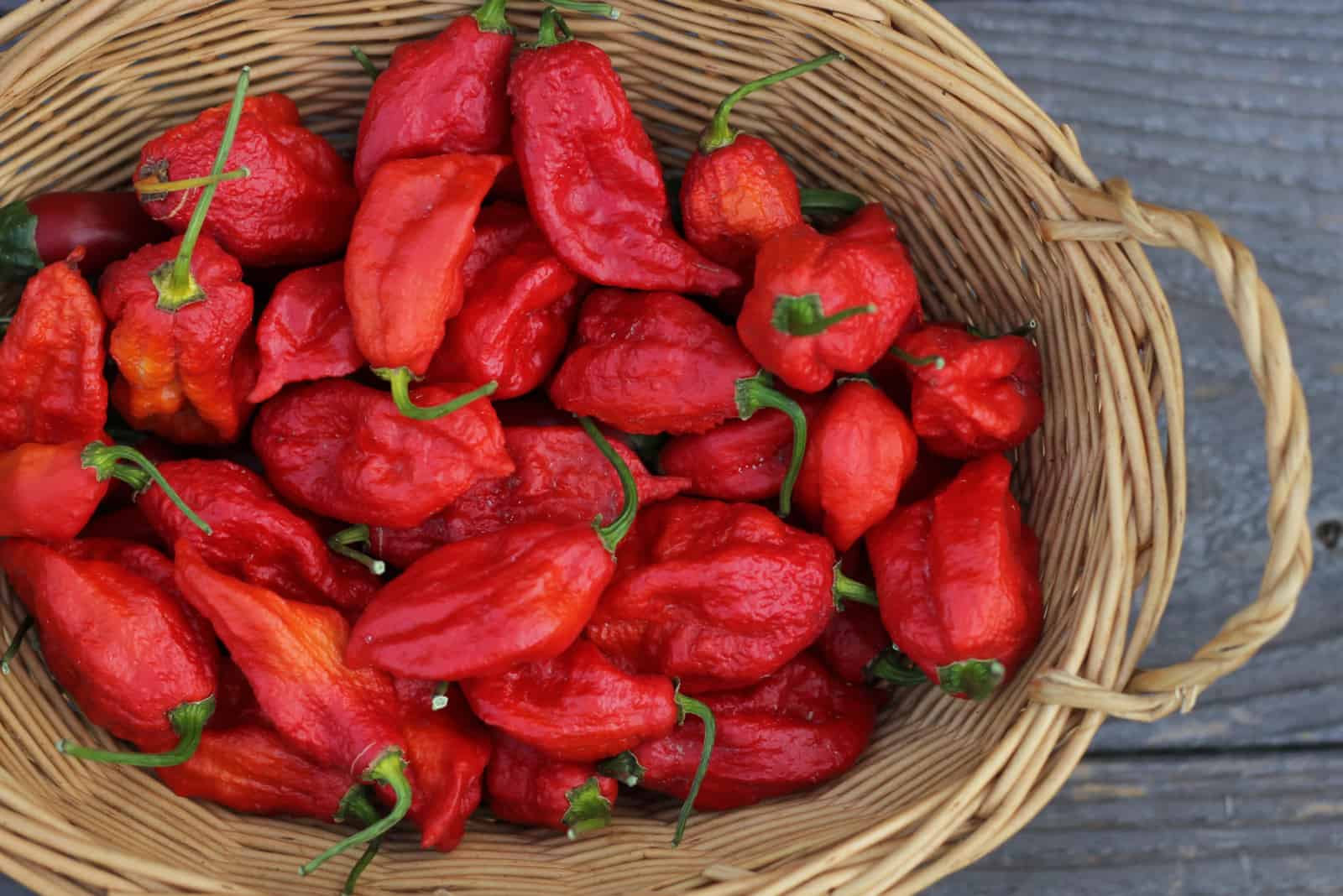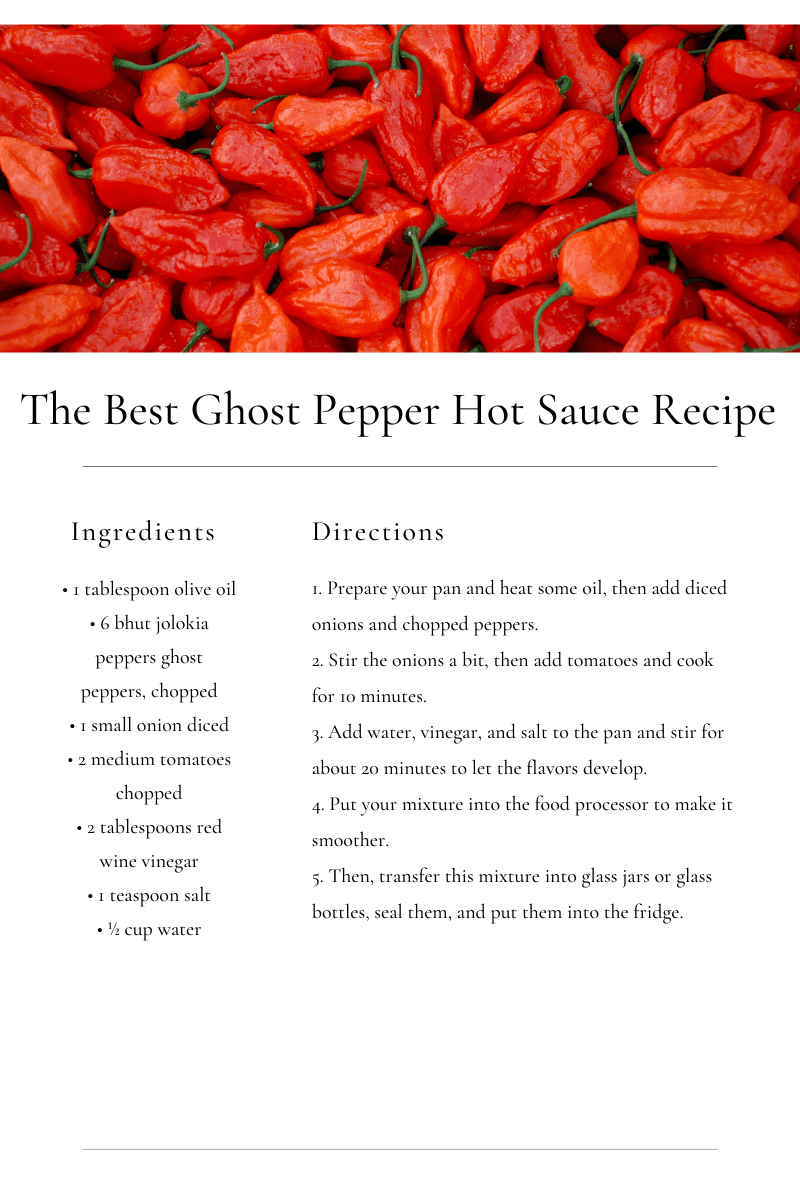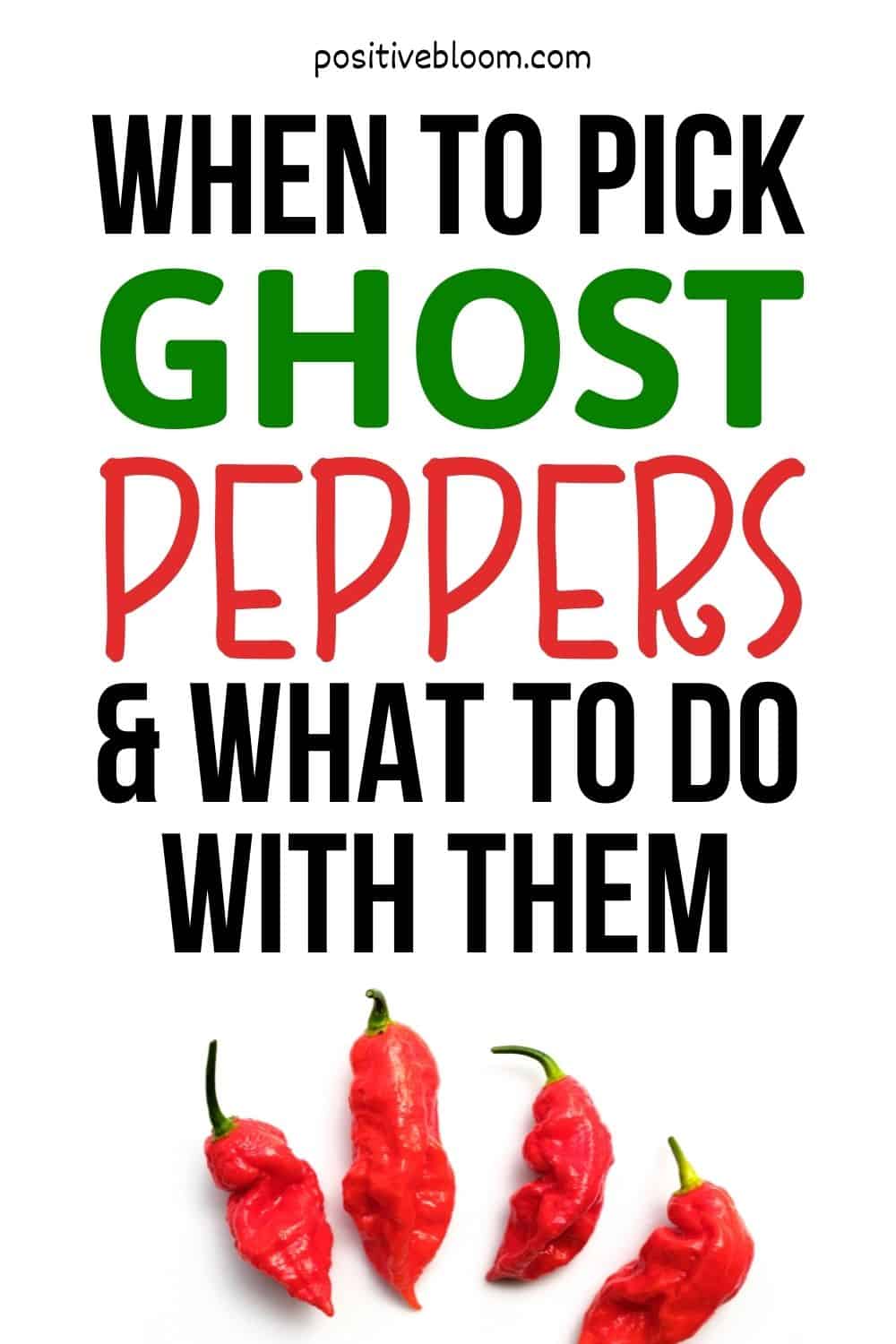If you have decided to spice up your garden by planting some chili peppers, and you need to know when the right time to harvest your peppers is, this is the article for you!
Don’t worry if you are a gardening newbie, it’s not that hard to determine whether your peppers are ripe.
Gardeners often choose Ghost peppers because they have a fruity, spicy flavor, which is why we use them to make hot sauces when we want to add a touch of spiciness to our meals.
In addition to this, they are easy to take care of and were once proclaimed as the world’s hottest peppers, so they are pretty famous!
If you have planted the seeds and now you are not sure about when to pick ghost peppers, continue reading this article to find out the answer and more!
How To Know When To Pick Ghost Peppers
If a few months pass by after planting your Ghost pepper seeds, and your other hot peppers are fully matured while your Ghost peppers still look unripe, don’t worry!
There’s nothing wrong with your peppers, they just need a little bit more time to fully mature. Even though you have to wait a little bit longer, your Ghost pepper plants will eventually produce a lot of fruit in one growing season.
When to pick Ghost peppers actually depends on your intentions with them, for instance, if you want to make super hot sauces you should pick them at their peak of ripeness. If you don’t want your peppers to be extremely spicy, you harvest them a bit earlier.
You only really have to look at the color of your new peppers to determine their ripeness.
Ripe Ghost peppers will have a prominent red color and firm structure, which is the best time to pick them if you prefer eating them fresh.
If the ripe peppers are kind of soft and wrinkly, it usually means they are overripe, but you can still eat them. (Be careful though, because in this state they are extremely hot!)
In the beginning, the plant will start producing green peppers. They are unripe and slightly less spicy compared to peppers that have reached full maturity. You can pick unripe peppers if you don’t want your mouth to burn like hell!
Bear in mind that there are different Ghost pepper varieties that have different colors: yellow, peach, orange, brown, white… it really depends on the type of Ghost plant!
How Long Should It Take?
Prepare yourself for a long gardening journey when growing Ghost pepper plants. They have a very long growing season compared to other plants.
They usually take about 5 months to reach full maturity, although sometimes it can take a bit longer. I waited 6 months for my ghost peppers, but it was totally worth it!
Even Ghost pepper seedlings require more time to germinate. You usually have to wait about 2 weeks for germination, but sometimes it can take a month.
If you want to have peppers ready by the end of the growing season, I would suggest you start your plant indoors about 2 months before the last frost, then transplant them outside when the temperature gets warmer.
How do you pick a Ghost pepper?
It’s quite easy to harvest your freshly grown peppers, just use scissors to snip them off!
If you don’t have any, you can simply use your hands, but be careful not to rip off the entire plant! I would suggest you wear gloves when harvesting ghost peppers, especially if you have sensitive skin.
You should wear safety goggles as well, because you might accidentally tear the pepper and the juice can get in your eyes – this happened to me and I thought I was going blind!
More About Ghost Peppers
Ghost peppers are actually a hybrid plant made by crossing Capsicum Chinense with Capsicum Frutescens. Bhut Jolokia and Naga Morich are different names for this type of pepper, although we call it Ghost pepper most of the time.
Ghost peppers are not scary looking, but they are scary tasting! With 1,041,427 Scoville Heat units (SHU), it was certified as the hottest pepper in 2007 by the Guinness book of World Records!
Unfortunately, it was beaten pretty quickly because it seems like cultivators are competing with each other to see who can breed chili peppers with the highest SHU.
Today, ghost chili peppers are in the top five peppers on the Scoville scale, together with Carolina reapers and Habanero peppers.
The Scoville scale measures the amount of capsaicin present in the peppers, which is a chemical agent that makes them spicy.
There are numerous types of Ghost peppers, and they slightly differ in heat levels and color, but their plantation and care guides are practically the same.
Types of Ghost Pepper Plants
Orange, yellow, red, white, brown, and peach – these are the colors of different Ghost pepper varieties. If you want to have a colorful garden, you might as well plant different types of peppers!
Other than their different colors, are there any other differences?
Read on to find out the answer.
1. Red Ghost Pepper
As the hottest among all the Ghost pepper varieties with 1,041,427 SHU, the Red Ghost pepper is a popular pepper with a somewhat smoky, and very spicy flavor.
It starts off as a small, green baby pepper that develops into this big pepper with a fiery red color. Wrinkled skin is a sign of a fully matured pepper, which is the perfect time to harvest your peppers and eat them fresh – if you dare!
2. Yellow Ghost Pepper
With slightly lower heat levels, the Yellow Ghost pepper is a close relative of the Red Ghost pepper, albeit with lower heat levels. Nonetheless, it is still a super hot pepper that is actually 125 times hotter than Jalapeno peppers!
A special thing about this plant is that it isn’t a hybrid; it is naturally found in the United States, which is pretty uncommon for chile peppers with 855,000 SHU.
3. Orange Ghost Pepper
Orange Ghost peppers have a citrusy, sweet flavor, but this doesn’t mean they’re lacking any spiciness, don’t you worry.
It is a fast-grower compared to other Ghost pepper varieties, and it has somewhat smoother pods.
Orange Ghost peppers are similar to the Orange Habanero, as they’re both prevalently used to make hot sauces and jams!
4. White Ghost Pepper
This Ghost pepper variety is probably the only one that actually looks like a little white ghost. We often think of the color red when it comes to chili peppers, but in this case you should still be careful!
This white little devil is extremely hot, and you will definitely need a fire extinguisher when eating fresh White Ghost pepper!
The White Ghost pepper plant grows relatively small compared to other types, but sometimes big things come in small packages!
5. Green Ghost Pepper
The Green Ghost pepper is probably the most popular type, just because all of the Ghost peppers were once green!
This means that it can be tricky to detect the ripeness of Green Ghost peppers, and you might not know when to pick ghost peppers in this case. The best thing to do is investigate the texture, and if it’s wrinkly, then it’s probably ripe.
The Green Ghost pepper is slightly less spicy than the Red Ghost Pepper, and it has a fruity flavor which is often used for making hot sauces.
6. Purple Ghost Pepper
The edgy one among the Ghost Pepper varieties! The Purple Ghost Pepper has a prominent purple color and looks just like a plum.
However, if you leave them to grow a little bit longer, they will change color to red, which is an indicator of complete ripeness.
They grow smaller pods compared to other peppers, although they are not as hot as the rest of the Ghost pepper plants.
If you don’t like extremely hot peppers, the Purple Ghost Pepper is the right choice for you.
7. Peach Ghost Pepper
I should warn you now – they do not taste like peaches at all!
This type of Ghost Pepper got its name because of its color, which resembles the color of a peach.
They grow the largest of them all. The plant can grow about 6 inches tall, and the peppers change color to orange when fully ripe.
8. Chocolate Ghost Pepper
Can you guess how these got their name?
That’s right, they taste exactly like chocolate…not!
Though they have a sweet aftertaste, they are just as spicy as the Red Ghost pepper. They got their name because these peppers change color to brown as they mature.
Chocolate Ghost peppers are aromatic and they have a smoky flavor, which can be used as a perfect touch of spiciness in salsas and sauces.
How To Plant Ghost Peppers
Buying the seeds is the easy part, but how do you actually plant the pepper seedlings?
As they have a relatively long growing season, I would recommend you start your peppers indoors at least 8 weeks before the last frost.
You should put the seeds in water the night before planting to soften them a little bit.
Prepare some small pots for your seeds by filling them with proper potting soil. You can use a universal potting mixture combined with peat moss. After sowing the seeds, provide them with a warm temperature and keep the soil moist.
The germination will probably occur in the first two weeks, however sometimes it can take a month for the seeds to germinate. When you see the little sprouts, provide them with enough sunlight.
After your baby ghost pepper has grown from 4 to 6 inches, it’s time for them to leave the nest, that is, to transplant them outside. At this growing stage, the seedlings are ready to grow outside!
A week before transplantation, provide your seedlings with a lower temperature to harden them by moving your pots somewhere sunny outdoors and leaving them for a few hours.
Transplantation
Dig a hole large enough to fit the root ball of your plant, and carefully transplant the plant into the hole. Bear in mind that the plants should be at least 30 inches apart from each other.
I know that growing hot peppers indoors takes a lot of time and energy, which is why you can buy pre-prepped plants ready for transplantation!
How To Grow Ghost Pepper Plants
The trick to growing Ghost Pepper plants is to mimic their environment by providing them with hot and humid conditions.
Between this and the long growing season, Ghost pepper plants are pretty hard to cultivate. However, it’s worth it in the end!
If you are patient enough and follow the care guide below, you will be able to grow delicious chile peppers in your own garden and use them to make the perfect hot sauce!
Soil
Ghost pepper plants thrive in well-draining and nutrient-rich soil, with pH levels between 6.0 to 6.8 (you should do a soil test before planting).
When it comes to soil temperature, at least 73 degrees Fahrenheit will keep your pepper plant happy and healthy!
Water
Ghost pepper plants don’t like soggy soil as it can lead to root rot, so you should water them thoroughly at least once a week.
However, the watering requirements depend on a lot of different factors like humidity and temperature, so maybe your pepper plants might need a bit more water than usual.
It would be best to see if the soil has dried before watering. If you don’t mind getting your hands a little dirty, use your thumb to see whether the soil is dry or moist and if it’s dry, water it, and if not, then water it in a few days.
Make sure not to over water your plant. In addition to root rot, it can really mess up the flavor of your peppers and they will have a bitter taste instead of spicy.
Temperature
Ghost peppers thrive best in warm climates, especially in regions where it’s super hot! The climate is linked to the flavor: higher temperatures actually affect the spiciness of the peppers, making them much hotter than usual.
Anyway, these peppers enjoy temperatures ranging from 70 to 90 degrees Fahrenheit. Anything below would damage your plant.
Be aware that they don’t like changing temperatures, so gardeners often grow them in a greenhouse or even indoors.
Light
As they thrive in warmer climates, Ghost pepper plants absolutely love growing in full sun! They should get at least six hours of direct sunlight every day.
If you are growing them indoors, make sure to place them in a window that gets direct sunlight throughout the day. Your plant will love it!
Fertilizers
Fertilizers are food for plants, and your pepper plant needs nutrients to provide you with those delicious, hot chillies.
When it comes to fertilizer, your Ghost pepper plant will eat up a fertilizer high in potassium! Potassium is an important nutrient for pepper production.
They do not like fertilizers that contain high amounts of nitrogen, as they can cause overproduction of foliage, and your plant will focus on growing leaves instead of fruit.
You should apply fertilizer right after planting, and then two times throughout the growing season. Do not over fertilize your plant as it can lead to chemical build up that suffocates the roots.
Mulch is also added around the plants to retain moisture and prevent weed growth.
For more information about how to grow ghost peppers, click on this video:
Ghost Peppers Use
Due to the fact that they were once the hottest peppers in the world, surely they are going to be used to add a little bit of spice to meals and dishes.
You can eat them fresh, and they will have a fruity and somewhat sweet flavor at first, followed by extreme spiciness that will make you cry.
First onions, now the peppers – what’s up with vegetables making us cry all the time? It is like we are in a toxic relationship… but hey, at least we don’t have to worry about the spiciness. 😉
Anyway, let’s continue our list of Ghost Peppers uses: you can also dry them in the oven, then grind them into powders and voila!
Congratulations, you just made your very own chili powder.
However, they are mostly used to make hot sauces and salsas. If you harvest a large batch, don’t leave them to rot – you can always make delicious sauces and give them to your friends and family (they will either love you or hate you, depending on their personal taste!).
Even if you are not the biggest fan of spicy foods, I would recommend you at least try and eat one because Ghost Peppers are super beneficial to our health.
Capsaicin alone can improve your gut health so much, from killing the harmful bacteria and preventing illness, to speeding up your metabolism, which can lead to weight loss. Along with that, Ghost peppers can provide you with the recommended daily intake of vitamin C.
The Best Ghost Pepper Hot Sauce Recipe
If you have been wondering what to do with a large batch of ghost peppers, you have come to the right place!
I would recommend you make hot sauces. You can add small amounts to any meal and make it spicy, or you can use it to dip your foods in, which really comes in handy during the winter! Just take a drop of your sauce and it will immediately warm you up!
Don’t worry, you don’t have to spend that much energy and time to make the sauce – it is super easy. Simply follow the instructions below and make sure to wear safety gloves!
Ingredients:
• 1 tablespoon olive oil
• 6 bhut jolokia peppers ghost peppers, chopped
• 1 small onion diced
• 2 medium tomatoes chopped
• 2 tablespoons red wine vinegar
• 1 teaspoon salt
• ½ cup water
Instructions:
1. Prepare your pan and heat some oil, then add diced onions and chopped peppers.
2. Stir the onions a bit, then add tomatoes and cook for 10 minutes.
3. Add water, vinegar, and salt to the pan and stir for about 20 minutes to let the flavors develop.
4. Put your mixture into the food processor to make it smoother.
5. Then, transfer this mixture into glass jars or glass bottles, seal them, and put them into the fridge.
Frequently Asked Questions
1. What should the skin of a Ghost pepper look like?
Most ripe Ghost peppers have smooth skin with a wrinkle on the side, however overripe peppers will have much more wrinkly skin and will be a lot spicier. You can eat an overripe pepper if you have the stomach for it!
2. Are Ghost peppers hot when green?
Even when unripe, these green Ghost peppers can still burn you! They are slightly less hot compared to fully mature plants, but remember that we are talking about super hot peppers with over a million SHU, so even a tiny fraction of this can be super spicy.
3. What are some mildly hot peppers?
There are many chili peppers on the Scoville scale, starting from those that have 0 SHU (like Bell peppers), to middle ones that have up to 50,000 SHU (like cayenne peppers), and finally those that have over a million SHU (like the Carolina Reaper).
Mildly hot peppers according to the Scoville scale are Anaheim, Banana peppers, Poblanos, and Cherry peppers.
Conclusion
Ghost peppers are annual plants with a long growing season, which is why people often don’t know when to pick ghost peppers.
It is pretty easy though, just make sure you know which Ghost pepper variety you are growing and observe the color changes. Green peppers are usually unripe, while red, orange, yellow, or purple usually indicate full maturity.
You should know that these peppers are extremely spicy no matter the growth stage!
If you love super hot food, then you will absolutely love these super hot Ghost peppers. You should try your luck and grow them in your own garden. How cool would it be to use your own homemade salsa when eating chips and watching your favorite show?
However, if you don’t want to spend time and energy growing and cooking, then go to any grocery store and look for a hot sauce – you will definitely find one made out of Ghost peppers.
If you are not a fan of spiciness, then do not, I repeat DO NOT try to eat them!
Until next time!
Like this post? Share or pin it for later!


